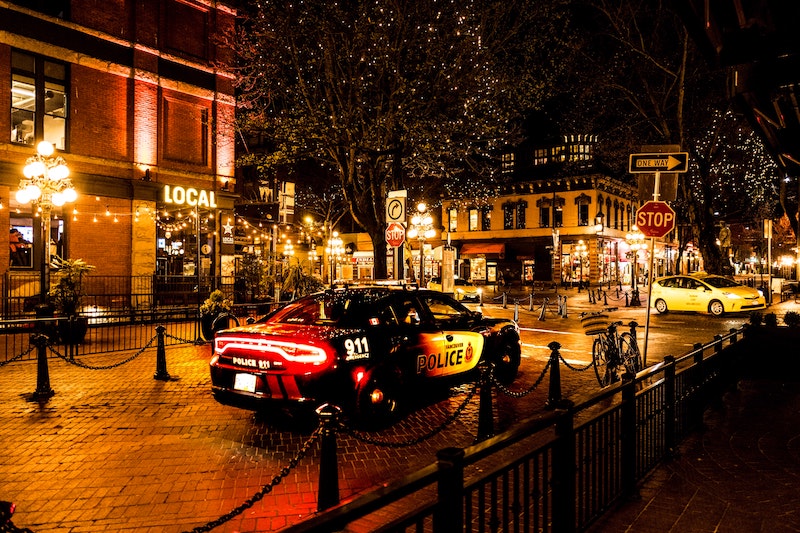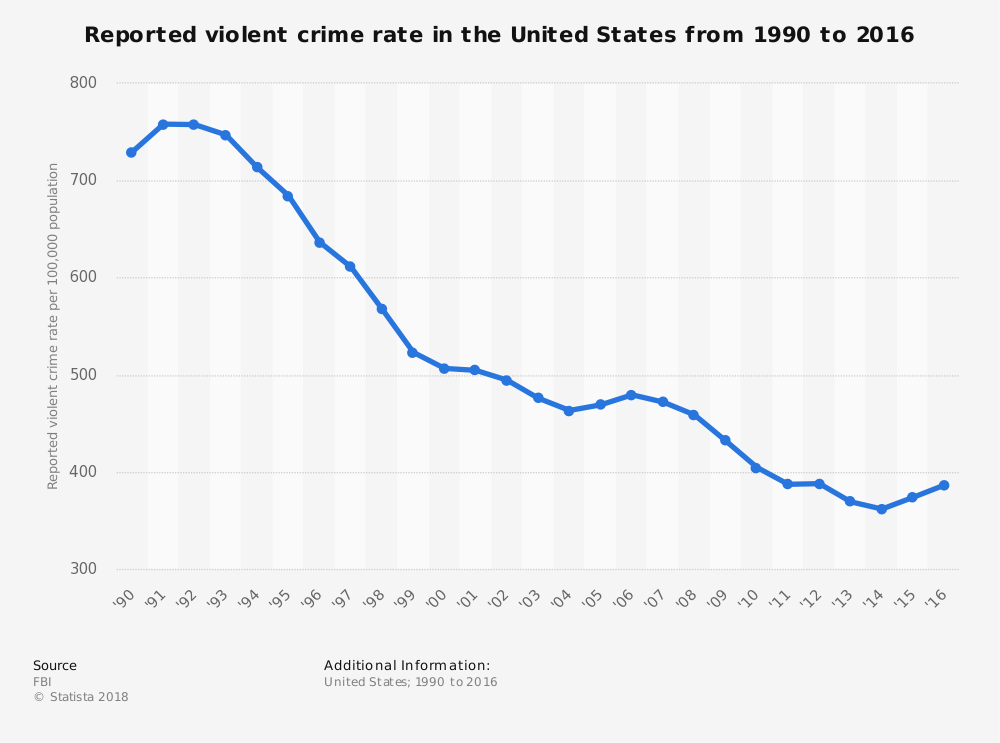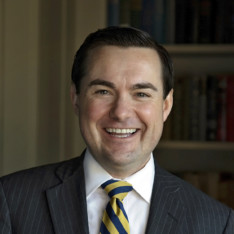Markets and Prosperity, Not Police, Will Fix the Crime Problem

Ronald Reagan famously stated, “The nine most terrifying words in the English language are: I’m from the government and I’m here to help.”
But should we apply such thinking to the police?
The answer depends on whom we ask. Many from the center-left who otherwise defend every government program and unionized job believe that the police are abusing their power. Many on the center-right who otherwise complain about unaccountable government officials consider the police department beyond reproach and say that any form of de-policing will make America less safe.
Then there is the daily experience of people that only rarely makes the headlines. Radley Balko does yeoman’s work to unearth the demoralizing, dehumanizing, and wholly unjustified treatment of average citizens at the hands of the police in many places around the country.
You can read his harrowing and detailed account of a conventional traffic stop in Arkansas turned extremely dark and ended up wrecking an innocent person’s life. This is one of thousands of such cases. It’s not about shooting and killing; it’s about harassment and the petty use of power.
And this what is reported. How much is unreported?
The Decline of Crime
Crime has decreased significantly in the past two decades, and many attribute that outcome to the proactive “broken windows” policing first advocated by James Q. Wilson and George L. Kelling in a 1982 article. The theory goes that arresting offenders for minor crimes like loitering or drinking in public leads to a mien of order that in turn discourages major crimes. Citizens will be better off with, and thus prefer, police playing an active role in the community.
Surveys today, though, show citizen confidence in the police is mixed at best, better today that two years ago but still not high. Confidence has dropped among Americans of all ages, education levels, incomes and races, with the decreases particularly pronounced among the young and minorities.
According to a USA Today/Pew Research Center poll, only 30% of African-Americans say that they have a great deal or quite a lot of confidence in the police, and nine out of 10 say that the “police do an ‘only fair’ or poor job when it comes to equal treatment and appropriate force.” Nine out of 10 Americans surveyed say that officers should be required to wear body cameras to check police violence.
These last several years have seen extraordinary killings, both by police officers and of police officers, in St. Paul, Baton Rouge and Dallas. All across the political spectrum, people agree that American policing is in turmoil. But different groups emphasize different aspects of the problem of police abuse. Where Black Lives Matter protesters emphasize the danger of being killed by the police, Blue Lives Matter counter-protesters emphasize the risks faced by hard-working policemen. The issues are so polarizing as to leave little room for considered thought or discussion.
An Economic Perspective
As an economist, I’d like to advocate taking a step back and looking at the data to begin to gain some perspective. In 2015, 41 officers were slain in the line of duty. That means the 900,000 U.S. law-enforcement officers face a victimization rate of 4.6 deaths per 100,000 officers. Any number greater than zero is a tragedy, but the average American faces a nearly identical homicide rate of 4.5 per 100,000, and the average male actually faces a homicide rate of 6.6 per 100,000. Being a police officer is thus dangerous but not as dangerous as being an average American male.
In the same year, police killed 1,207 Americans, or 134 Americans per 100,000 officers, a rate 30 times the homicide rate overall. Police represent about 1 out of 360 members of the population, but commit 1 out of 12 of all killings in the United States. Many argue that these are justifiable, but are they necessary? In England and Germany, where the police represent a similar percentage of the population as in the U.S., they commit less than one-half of 1% of all killings. Are higher rates of violence inevitable in our country with its more heavily armed populace, or can things be done to reduce the growing tensions?
Former policeman Norm Stamper’s book “To Protect and Serve: How to Fix America’s Police” provides a first-hand account of the changes in policing over the past few decades and is a useful survey of how we got here. He started as a beat cop in San Diego in 1966 and rose to be chief of police in Seattle from 1994 to 2000. He witnessed both the more discretionary eras of policing and the advent of broken windows policing, which was first adopted in New York City in the 1990s and evolved into an aggressive form of proactive and “zero-tolerance” law enforcement that spread across the nation.
Mr. Stamper joined the force out of a desire to serve the community but quickly learned that his performance would be judged on the number of tickets he wrote and arrests he made. An experienced officer told him, “You can’t let compassion for others get in the way.” There were quotas to fill. “The people on my beat were, in a word, irrelevant,” Mr. Stamper writes.
The war on drugs was declared in 1971—then escalated in the 1980s—and Mr. Stamper noticed police increasingly treating civilians like enemy combatants. In 1994, President Clinton passed the largest crime bill in history. It allocated $8.8 billion to hire 100,000 more police officers and $10 billion for new prisons, and it established mandatory arrests for allegations like domestic violence and mandatory life sentences for third-time drug or violent offenders—the three-strikes provision. Incarceration rates spiked nationally. The rate at which the government incarcerates Americans is now seven times what it was in 1965.
“To Protect and Serve” is particularly disturbing in showing that, as antagonism toward and disregard for the public increased among policemen, it had few consequences. Officers do not report on their colleagues, and prosecutors are averse to punishing people with whom they must work closely. Mr. Stamper quotes a fellow police chief saying: “As someone who spent 35 years wearing a police uniform, I’ve come to believe that hundreds of thousands of law-enforcement officers commit perjury every year testifying.”
Instead of policemen serving the public, Mr. Stamper concludes, they end up viewing citizens as numbers or revenue sources. One important lesson from economics is that unaccountable government officials will not always act on the public’s behalf.
Malfeasance in Policing
Another account of modern policing is “A Good Month for Murder: The Inside Story of a Homicide Squad” by Del Quentin Wilber, a newspaper reporter who spent a month alongside detectives in one of the Maryland suburbs of Washington, D.C. This attempt at a true-crime drama seems to have been meant in praise of police work, but Mr. Wilber unintentionally creates an unflattering picture. He shows us men who refer to their targets as “reptilian motherf—ers” and conduct multi-hour interrogations in the middle of the night to elicit confessions. They throw chairs against walls to intimidate suspects, lie boldly during interrogations and happily feed lines to witnesses to use in court.
One detective “jokes with [another] that he could get [a suspect] to confess to anything: ‘Have any open murders that need to be closed?’” The Fourth Amendment to the Constitution attempts to restrict search and seizure without probable cause, but judges here grant warrants without a thought: “He just immediately signed the paper and looked at me and winked and said, ‘Good luck.’ ” At one point, a supervisor explains that a prisoner cannot be questioned about earlier crimes without having a lawyer present. The detective retorts: “F—ing Constitution.” In the end, the policemen excuse any mistakes they made by saying they had good intentions.
A company that mistreats its customers cannot stay in business merely by saying it acted with good intentions. The police, by contrast, are a tax-funded monopoly, paid regardless of how well they serve or protect. Citizens subject to random fines or harassment cannot turn the police away if they are unhappy with their services. The Justice Department investigation of the Ferguson, Mo., police department provided an in-depth account of local politicians, police, prosecutors and judges using the legal system to extract resources from the public.
In 2010, the city finance director even wrote to the police chief that “unless ticket writing ramps up significantly before the end of the year, it will be hard to significantly raise collections next year. . . . Given that we are looking at a substantial sales tax shortfall, it’s not an insignificant issue.” In 2013, he wrote to the city manager: “I did ask the Chief if he thought the PD could deliver [a] 10% increase. He indicated they could try.” The Ferguson police department evaluated officers and gave promotions based on “citation productivity,” and prosecutors and judges worked alongside them to collect revenue.
In a city with 21,000 residents, the courts issued 9,000 arrest warrants in 2013 for such minor violations as parking and traffic tickets or housing-code violations like having an overgrown lawn.
When the Ferguson citizenry started mass protests against police abuses in 2015, they were met with the equivalent of a standing army. The news photographs of police in camouflage, body armor and helmets working in military formation with guns drawn were a wake-up call for many Americans, who wondered just how the police came be so militarized. It was all part of the spread of zero-tolerance policing in the 1990s.
After the 1994 crime bill, President Clinton signed a law encouraging the transfer of billions of dollars of surplus military equipment to police departments. Mr. Stamper describes applying for military hand-me-downs of “night-viewing goggles, grenade launchers, bayonets, assault rifles, armored land vehicles, watercraft, planes and helicopters.”
The Department of Homeland Security provides $1.6 billion per year in anti-terrorism grants that police departments can use to purchase military equipment. Police in Hartford, Conn., for example, purchased 231 assault rifles, 50 sets of night-vision goggles, a grenade launcher and a mine-resistant vehicle. As recently as the 1970s, SWAT raids were rare, but police now conduct 50,000 per year. The weapons and tactics of war are common among what Mr. Clinton promised in 1994 would be “community policing.”
The question is just what would happen if law enforcement toned down its zero-tolerance policies?
Defender of the Police
One of the premier defenders of the police against critics is Heather Mac Donald, a scholar at the Manhattan Institute who publishes regularly in the nation’s most popular newspapers, including this one. Her book “The War on Cops: How the New Attack on Law and Order Makes Everyone Less Safe” organizes and builds on her articles to create a narrative that warns against adjusting police tactics or lowering incarceration rates. She takes aim at groups ranging from Black Lives Matter to “the Koch brothers [who] have teamed up with the ACLU, for example, to call for lower prison counts and less law enforcement.”
Much of the book is focused on the post-Ferguson state of policing, but it also includes some of her warnings and predictions from recent years. In a chapter drawn from a 2013 article, for instance, Ms. Mac Donald worries that in the first full year after the court-mandated 30% decrease in California’s prison population, the state’s “crime rate climbed considerably over the national average.” And in one from 2014 she writes that the 2013 ruling that led to the elimination of “stop-and-frisk” tactics in New York has set in motion “a spike in violence.”
Yet between 2008 and 2014, homicides fell by 21% in California and 34% in New York; crime in other categories was down, too. In the very year when Ms. Mac Donald suggests crime rates were climbing in California, homicide rates fell 7%. This was equally true for New York City after stop and frisk was outlawed; homicide rates were ultimately down 0.5% in 2014. It appears that keeping those extra 46,000 Californians behind bars or subjecting New Yorkers to 4.4 million warrantless searches between 2004 and 2013 was unnecessary for public safety.
More recently, Ms. Mac Donald has warned about a “Ferguson effect” that has led to a “rise in homicides and shootings in the nation’s 50 largest cities.” Starting in the summer of 2014, anti-police-violence protests have prompted large reductions in aggressive policing, and Ms. Mac Donald points to increases in crime in cities including Baltimore, Minneapolis, Milwaukee and Nashville. She states that we are seeing a “surge in lawlessness” and a “nationwide crime wave.” FBI data, however, compares the first six months of 2014 and 2015 and shows that violent and property crime have both decreased in dozens of large cities, including Cleveland, Detroit, Houston, New York and Philadelphia. From 2014 to 2015, violent crime did increase by 1.7% nationwide, but property crime decreased by 4.2%.
Any data series will have some fluctuation, and even with a sustained downward trend upticks are likely. The homicide rate, for example, has seen rises in four of the past 15 years but has fallen by 18% over the same period. To put the 1.7% “surge in lawlessness” into perspective, 2012 saw a 1.9% increase in violent crime and a 1.5% increase in property crime when zero-tolerance policing was still the norm nationwide. And such a modest increase from one of the safest years in decades did nothing to change the fact that crime remained—and remains—close to a record national low.

Ms. Mac Donald is not alone in her thinking. Gallup does an annual survey asking, “Is there more crime in your area than there was a year ago, or less?” In 14 of the past 15 years, the majority of Americans felt that crime had increased. But answering empirical questions requires looking at the numbers.
A Data-Driven Account
A data-driven book that does not engage in alarmism is “The Rise and Fall of Violent Crime in America” by Barry Latzer, a professor at the John Jay College of Criminal Justice. The long-term trends in violent crime he presents are telling: In 1900, the American homicide rate was 6 per 100,000 people. During Prohibition, it increased to 9 per 100,000 but fell to 4.5 per 100,000 by the 1950s. From the late 1960s and into the 1970s, the homicide rate spiked, reaching 11 per 100,000. In the late 1970s, it started falling, increasing slightly in the late 1980s but steadily decreasing since the 1990s to the current level of 4.5 per 100,000, among the lowest in the nation’s history.
Should one attribute the decrease in crime to zero-tolerance policing and mass incarceration? It turns out that homicide rates in Canada start at a lower level but track the changes in American homicide rates almost exactly.
In the past 25 years, our northern neighbor experienced equal declines in all major crime categories despite never having ramped up its policing or incarceration rates. Those attributing all decreases in crime to increases in American law enforcement are looking in the wrong place. As Mr. Latzer carefully says, “the jury is still out”: Violent crime rates “fell off all over the nation without any clear relationship between the enormous declines in some cities and the adoption of new policing models.”
Even though American and Canadian homicide rates rose in the late 1980s, the long-term downward trend clearly began in the late 1970s and early 1980s. Mr. Latzer concludes that the major determinants of a crime rate are likely cultural factors and economic opportunity. The employed family man is going to be less interested in crime than the unemployed and unattached.
Two years ago we heard predictions about the world economy’s impending collapse if Britain left the European Union. Yet within a week of the Brexit vote, British stock prices reached 2016 highs, and American stock prices are at an all-time high. We can be sure that we will hear similar warnings in response to proposals for lowering incarceration rates, reducing the number of policemen, de-militarizing police departments or even privatizing much or all of what they do. Yet, as Messrs. Stamper and Latzer point out, professional police departments were only invented a century and a half ago, and in 1865 New York incarcerated fewer than 2,000 citizens at any given time, compared with upward of 80,000 today (48 per 100,000 then versus 265 per 100,000 now).
Then, as now, societies were kept safe by numerous factors beyond government-sanctioned law enforcement. These range today from the most informal eyes on the street to the more formal million-plus private security guards currently employed in America. Around New York City, business improvement districts pay for security personnel to do foot patrols, so the relevant policy choice is not between government police or no security whatsoever.
My own research has also found a strong negative correlation between homicide rates and economic freedom in a society. Free markets let people put their passions into business to work for others’ benefit. Restrictions on business, including minimum-wage laws that keep young inner-city residents out of the labor force, are particularly harmful.
We need more markets, not more government, to discourage and prevent crime. One need not assume that unionized, militarized, and unpopular policemen are the only option for keeping the peace and keeping Americans safe.
__
This piece is adapted from a piece by the author originally published in the Wall Street Journal.











